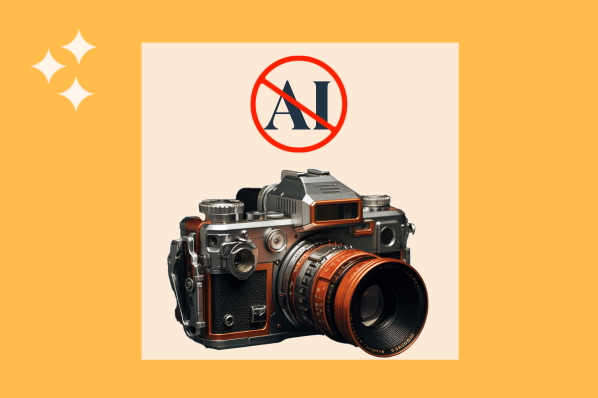To be eligible for a Clio, campaigns must also run publicly in their entirety, meaning that advertisers can't submit special director's cuts to the Clios -- they have to submit the version that appeared on TV or wherever the ad originally run.
To help inspire your next big marketing campaign, I've compiled a list of advertising campaigns awarded a Clio Gold or higher at the 2019 ceremony. For each example, I'll also discuss some insights that marketers can gain from each and explain how you can implement something similar in your next campaign.
Commercials
1. "The Truth Is Worth It: Perseverance" (New York Times)
The New York Times' 2018 ad, "The Truth is Worth It: Perseverance," focuses on the long, often challenging path towards verifying facts for a story. It also emphasizes the barriers reporters must overcome to complete and report on a thorough investigation.
This advertisement, which won both a Clio Gold and Grand award, creates a sense of tension by showing actual footage -- primarily recorded by journalists -- related to child separation and deportation in the U.S. As the footage, which includes imagery of fences and children letting go of their parents' hands, plays, you can hear soundbites of immigration reporter Caitlin Dickerson making a number of calls to confirm family separations at the border.
In the stream of sound bites, Dickerson gets hung up on or disconnected from who she's speaking to a number of times. Then you hear conversations between Dickerson and sources that confirm certain facts about the story she's writing.
Along with intense soundbites and visuals that tell the story of a family separation investigation, you begin to hear typing sounds and see text overlays that look like typed notes. These notes, which you can assume are being typed by Dickerson, mirror the quick facts that a reporter might jot down as they're quickly calling multiple sources and writing on a deadline.
As you near the end of the ad, after you've heard Dickerson make multiple calls and get hung up on by countless sources, Dickerson starts typing notes that are now closer to actual sentences. The last sentence, which is formatted as a headline, says, "Hundreds of Immigrant Children Have Been Taken From Parents at U.S. Border." The statement is identical to the headline of an actual investigative article Dickerson published confirming child separation in 2018.
This New York Times commercial grabs your attention because it gives you a glimpse of how the publication searches for truth, confirms facts and aims to ensure accuracy in their reporting.
In “The Truth is Worth It,” The New York Times aims to show audiences why it is a trustworthy source by telling viewers a story about how its reporters go to extraordinary efforts to discover truths.
If your company wants to focus on building trust with a target audience, you could consider a video marketing strategy that offers viewers transparency into the inner-workings of your business.
For example, if you want to promote your organic restaurant, you could create a video marketing campaign that shows the process of how your food is grown, farmed, stored, and brought to a customer's table. This will give your customers an inside look at how your organic meals are made and help them trust you more when they see that it's produced in an ethical, safe, and organic way.
Gaming
2. "Making Fortnite Fresher" (Wendy's)
In the past few years, audiences of primarily 18 to 34 -year-olds have begun to use the website Twitch.tv to start live streams of themselves playing all sorts of different video games.
During a Twitch stream, viewers can see the game that a streamer is playing, as well as a small screen showing the streamer themselves. Streamers can also speak about the game and give commentary so viewers understand why they are doing a game strategy. Users who start streams on Twitch can also receive money if other users subscribe to their channel and watch their streams.
After the launch of Fortnite, an online video game, the Twitch streaming trend blew up. When playing Fortnite, you can team up with online friends or other virtual strangers to complete missions, battle others, or just explore the game's variety of interesting lands. Because you can create characters, fight in wars, and cultivate communities online, many players decided to start Twitch streaming their Fortnite games like storylines.
Some streamers, like one man named Ninja, even began to earn major subscription dollars and brand sponsorships while playing Fortnite over streams.
At some point in Fortnite's online storyline, players were given a mission where they were told to hunt cattle in the game, harvest the beef, and bring it to one of the nearby restaurants. Once they placed the beef in the freezer, players would receive coins that they could use to buy battle weapons, ammunition, and other gear for fighting other players.
Wendy's, which claims to sell "Fresh, Never Frozen Beef," has a company policy against placing beef in freezers because it makes the meat less fresh than it is when refrigerated. So, when the restaurant chain's marketing team found out the Fortnite was prompting players to put beef in freezers, they decided to launch a nine-hour Twitch stream where a Fortnite avatar dressed like Wendy ran around the video game attempting to destroy all the freezers. As a Fortnite player, you could join Wendy and help her smash the appliance.
According to the Clio sizzle reel, this Wendy's stream began to go viral as more people logged in to watch and post in the comment thread. Gamers also began to start attacking freezers to help Wendy's avatar. People also began to tweet about the fast-food chain's stunt. One tweet described the avatar's freezer rampage as "Savage Marketing."
Meanwhile, gamers who crossed paths with Wendy's avatar while filming their own Twitch streams pointed her out to their viewers. One Twitch streamer who was playing Fortnite and saw Wendy destroy a freezer of unfresh meat said, "She's making Fortnite fresher." This comment led to Wendy's making the formal title of this campaign, "Making Fortnite Fresher."
This Wendy's Twitch stream event, which one a Gold Clio, is a fascinating and innovative way of spreading brand awareness while entertaining your prospective customers.
The Twitch and Fortnite demographic is similar to that of most fast-food demographics. Like fast-food lovers, gamers are primarily between the ages of 18 and 34. While some people in this demographic might not respond well to other content, like ads related to professional services or B2B marketing, these young adults might enjoy or remember gaming ads related to fast-food brands.
This Wendy’s Twitch stream is a great example of how a brand can identify and leverage places where its demographic is already consuming content. This Fortnite-based campaign also shows marketers how they can use gaming and live-streaming as a new place for testing out interactive marketing strategies.
While placing an ad in a video game or on Twitch might be expensive, Wendy's strategy is still a good example of how a brand can think outside the box, identify new or emerging platforms that their audiences might use, and learn how to interact with audiences on them.
As a small or medium-sized business marketer, you probably shouldn't use all of your time or resources to manage a nine-hour Twitch stream. Instead, you can keep an eye out for other new or emerging platforms that might be more accessible to you. For example, you might find that a lot of people within your audience fit the demographic of -- or are already on -- TikTok.
Once you realize that TikTok or another new platform could be a good opportunity for you, research it by reading news or blog posts, learn what its users respond to, find out how similar brands use the platform, and then brainstorm creative ideas that will engage new audiences there.
Branded Content
3. "Big Mac vs. Big Mac" (Burger King)
Burger King is no stranger to sassing its fast-food competitors. If you follow Burger King's official Twitter, you'll see that the brand's social media team regularly, and entertainingly, makes snarky comments at companies like McDonald’s and Wendy's.
In a Gold Clio-winning 2018 video called Big Mac vs. Big Mac., the Burger King marketing team takes sass and snarky comments even further by getting their hands on McDonald's Big Mac recipe, flame-grilling their own version, and feeding it to a handful of Big Mac lovers along with a real Big Mac to see if the McDonald's fans can tell the difference.
The video is no longer on YouTube or embeddable, but you can watch it here.
At the beginning of the Big Mac-filled video, which was made in collaboration with BuzzFeed, a narrator says, "People love their Big Macs. But here at Burger King, we know the secret to a great tasting burger is flame grilling. How can we convince other people that flame grilling is the best way to cook a burger? -- By convincing our toughest guests: the Big Mac lovers."
The narrator introduces a taste-test experiment called "Big Mac vs. Big Mac," explaining that Burger King replicated a flame-grilled version of the burger to see if its fans would notice the difference between the McDonald's version and the copycat.
After the introduction, the video shows Burger King staff trying to track down the Big Mac's secret recipe in order to recreate it as closely as possible. The video demonstrates how challenging getting the recipe is by showing footage of a non-uniformed Burger King employee asking an uncomfortable McDonald's cashier if he can buy just the raw Big Mac meat patty.
Once the Burger King team tracks down the Big Mac recipe, they flame-grill the meat and serve it to the Big Mac fans. When asked which Big Mac is an older recipe and which is newer, the fans say that they think the flame-grilled version is new because it "tastes like a cookout" and is "one step above" the non-flame grilled burger.
As the video comes to a close, the Big Mac-eating participants are shocked to hear that the better Big Mac was actually from Burger King. One person sadly looks up the camera and says, "So I can never eat this again?" while another says, "So, is this on your new menu?" excitedly.
The narrator ends the video by saying, "The best Big Mac that money can't buy!"
The Big Mac vs. Big Mac video is an example of how a company can make themselves look better than its competitors while still seeming confident rather than desperate.
While any brand can make content that says its restaurant is better than a competitor’s, people ultimately love to hear recommendations and criticisms from real people who've tried the food. By having real McDonald's fans unsuspectingly explain why the Burger King Big Mac is better, the restaurant chain demonstrates that "flame-grilled is better."
On a smaller scale, you could run a campaign that highlights the reasons why your product or service is different from a competitor's. Because people love to hear recommendations from other real people, consider filming actual customers or product testers talk about why they'd buy from you over another brand.
By promoting a video that shows product testers analyzing your product over a competitor's, you'll be able to show audiences that you've gotten real recommendations from actual people or loyal customers. This might improve a prospect's level of trust more than ads that say your product is "the best" without actual proof.
Here's a real-world example of what this could look like. Say you sell dental supplies and you hear people saying that your toothpaste is better than a competitor's. You could leverage these compliments by making a competitive analysis video where normal people brush their teeth with your product followed by another brand's. At the end of the video, these people could explain why your product is better.
Showing that people prefer your product over another brand is obviously key to an effective competitive analysis video. But like Burger King, you should also show your product testers giving details about what makes your product unique.
Small comments such as taste descriptions might show viewers that a product tester is legitimately analyzing your product and is enjoying the experience of using it. If the testers seem realistic, viewers might trust that they're actually recommending the product and not just getting paid to say nice things about it.
4, "Broadway the Rainbow" (Skittles)
Instead of putting millions of dollars into one short Super Bowl advertisement, Skittles made a full-fledged musical titled "Broadway the Rainbow" -- which made fun of advertising.
The Skittles musical, which won a Gold Clio, was formatted as one large and obvious ad that told the story of how manipulative the marketing industry was. Throughout the musical, all of the characters regularly spoke and sang about how advertisements ruined their lives and how they were living in one giant Skittles commercial.
Even though Skittles charged $200 for each ticket, the musical sold out and went viral within days of its premiere. When the show was announced, USA Today called it, "the most inventive end run in the history of ambush advertising" because it capitalized on Super Bowl ads by immersing paying viewers into an obvious Skittles ad.
To make the show more exclusive for paying customers, Skittles never aired it on television or online. To give you a quick idea of what it was like, here's a highlight video that was submitted to the Clios:
Yes, creating a musical to advertise your company might seem like an outlandish way to spend your advertising dollars. But at a higher level, this campaign does show how marketers can get creative with ambush marketing to cause a buzz that gains attention from a wide range of audiences.
Ambush marketing or advertising happens when one brand creates a campaign that capitalizes on or mocks another brand's event or campaign.
While creating a musical to make fun of ads around the time of the Superbowl is a drastic example, other businesses have shown how smaller companies can take part in subtle ambush advertising.
One classic example was when a simple Rona billboard with only a French tagline translating to "We recycle leftover paint," was placed under an Apple iPod Nano billboard where different colors of paint poured down the canvas from each Nano.
Need a more modern example? A few years ago, when launching its Photo app, Google set up a pop-up food truck in Austin, Texas where they'd give people cupcakes in exchange for photos taken on with the app. During the promotion, Zappos placed a box-on-feet near the truck. Text on the box said that when fed a cupcake, it will dispense a container with a free product. This strategy allowed both Google and Zappos to get some good exposure.
Unless you want to capitalize on the Super Bowl or an annual event, ambush marketing usually isn't something you can plan out years in advance. If you want to try it out with your company, you'll need to keep an eye out for local places or time periods where launching a pop-up or discount can capitalize on another business's product launch or campaign.
For example, if you're marketing an e-commerce store and realize physical store that sells similar products is opening at a mall, consider advertising with posters in that mall that highlight a discount on competing items or says something along the lines of, "Do the physical stores not have what you need? Order it here."
In another example, if you sell products or services that are similar to other businesses in your neighborhood, consider offering a sale that occurs around the time another store is having a sale or grand opening. Then you could promote your sale by placing physical ads relatively close to the competing store.
When you're planning an ambush campaign, make sure your company comes off as clever rather than desperate. For example, shaming a competitor's store on social media every time they have a sale might look tacky. But creating an out of the box campaign that markets your product that rides on the coat-tails of someone else's campaign might be considered funny or interesting.
Before you launch, try to visualize how your audiences and the other brand's audience will react. Aim to engage the other brand's audience rather than making them think you took a cheap shot at a rival.
Regardless of which route you choose, be sure to understand the legalities behind ambush marketing. For example, you must be transparent with your audience about which brands you're affiliated with. For example, if you promote your business at an event, you can't say you're affiliated with that event if the organizers of it didn't explicitly say so.
5. "Uncle Drew" (Pepsi)
Since 2012, Pepsi has been promoting an "Uncle Drew"campaign where they've released short films about an elderly uncle, named Drew, who defines himself as a "baller."
Fueled by drinking Pepsi Max, Uncle Drew regularly dunks basketballs or wins games against teens in his neighborhood. Here's the first film which shows Drew walking onto the basketball court for the first time when his nephew’s team needs another player:
Because the commercials were well-received for many years, Pepsi expanded the Uncle Drew campaign in 2018 by making Uncle Drew swag, such as Bobbleheads in his likeness, and even a feature-length film.
The "Uncle Drew" film was the number one comedy in America during its opening weekend and was the reason the overall campaign had been nominated for a Clio. Here's the movie's trailer:
A campaign that involves producing a full-length musical or feature film is pretty costly and unrealistic for most marketers. But, a marketing video series might not be out of the question.
Many marketers, like Purple Mattress, have also created a video series that highlights their product through funny or fictional storylines. Here's one example of the Purple Mattress's Purple Boys series where a fictional character discusses how he has the "Sunday Scaries" and then easily falls asleep on a Purple Mattress.
If you don't have time to come up with an odd fictional storyline that centers around your product, you could still consider something non-fictional, like a podcast or video series that discusses topics related to your product or industry.
By crafting an online video series, people have even more chances of seeing a marketing video that relates to your content. If viewers enjoy the series, they might want to learn even more about your product. And, if your series provides them with interesting information about a topic, audiences might think your brand is incredibly knowledgeable and credible when it comes to your industry.
Social Media Campaign
6. "Insta Novels" (The New York Public Library)
The New York Public Library recently created an Instagram Story campaign aimed at proving that young people don't need to miss out on literature just because they're hooked on social media.
In the Insta Novels campaign, which took home a Gold and Grand Clio, The New York Public Library adapted entire novels into Instagram Stories to highlight the interesting literature that viewers could find at the library.
Novels that were displayed as Instagram Stories included "Alice's Adventures in Wonderland," by Lewis Carroll, "Metamorphosis" by Franz Kafka, and "The Raven" by Edgar Allan Poe. While pages and imagery were designed and animated specifically for the Instagram Stories format, the library still included the entire text of the book.
Posting entire novels and heavy text on pages of Instagram Stories is a bold move. Some brands have noticed that long Stories see a higher drop off rate as the platform's users are more accustomed to tapping through bite-sized Stories.
However, the New York Public Library was awarded a Gold Clio because they created a design that didn’t make the text or long-form Instagram content feel overwhelming. In fact, each page would only have just a few sentences of the novel's story on it. The library even added some nice animations on the sides of each page to make things more interesting to the viewer.
At the beginning of each Insta Novel, viewers were also instructed to place their thumb on each page's animation to prevent the Story from moving to the next page before they're done reading the text. This might be helpful to Instagram users who want to read the novel but are less familiar with using or navigating the Stories feature.
When Insta Novels were published, the library also used Instagram's Highlight feature to present the Stories permanently on its profile page. Then, users who came across the New York Public Library's profile could treat the Highlighted Stories like a virtual bookshelf.
While the New York Public Library is nailing social media design techniques, they’re also creatively using popular literature to highlight books that you might find in its catalog.
If you're trying to spread social media brand awareness in new ways, Instagram Stories can be a great outlet for creative content marketing experiments, like Insta Novels. For example, if your company has a blog, you could use Stories to show people animated or visual excerpts of what you're publishing. Then, if you're verified or have more than 10,000 followers, you could even gain traffic by including a swipe up link to the blog post you're promoting.
7. "Be a Follower" (Diesel)
Instead of hiring influencers to wear Diesel's clothing and share purchasing links for various items on social media, Diesel launched the "Be a Follower" campaign which allowed fans to create a virtual Diesel store and share the links to it on social media.
To create a virtual store, a fan would go to Diesel.com/baf/sidebiz, which is no longer active. Then they'd enter basic contact information into a form and press "Create." From there, they'd get a personalized link with their name on it that went to their own mini-Diesel website. When people clicked on a personalized link, they'd see a store that looked like Diesel's but had the name of the follower who generated it at the top of the page.
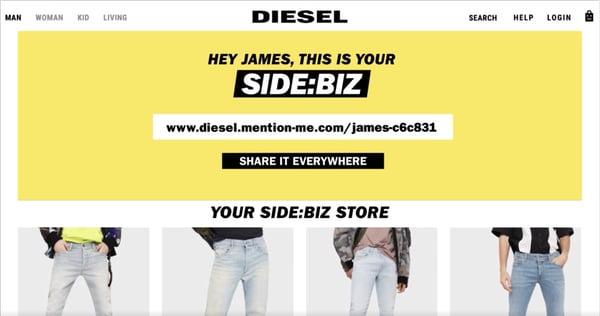
When someone purchased an item from a fan's store, that fan would get points that could be exchanged for Diesel clothing discounts or other rewards.
As people began to share their store links in social media posts, Diesel re-shared them on its branded social channels to help those followers get more store clicks. Since followers wrote about or included photos of Diesel products in the posts they share with their individual links, the clothing brand marketed both the campaign and its own products through re-sharing posts from its fans.
Using your customers as influencers is a very clever and cost-efficient strategy that embraces word-of-mouth advertising. And, recommendations from friends, family, or every-day people are still much more trusted than the average ad.
If you're on the marketing team for a company that can't afford to hire an influencer, consider a strategy that leverages both happy customers and social media.
By creating a campaign that encourages customers and fans to talk about why they enjoy your company, or share online store links, like Diesel's Be a Follower campaign, you could delight and reward your current customers while potentially gaining new prospects who trust the review they're seeing.
Physical Campaigns
8. "Billie Jean King Your Shoes" (Adidas)
In 1973, Billie Jean King won a tennis match against male player Bobby Riggs, which was coined "The Battle of the Sexes." The historic tennis game was the first time a female tennis player was matched against a male.
In and before the late 1950s, men were seen as superior athletes and breadwinners in society. Prior to the tennis match with King, who was only 25, even Riggs said that he could beat a woman at his age of 55.
King's tennis match win proved Riggs wrong. It also proved that men and women could compete equally on the tennis field and in other sports. On a bigger scale, it further empowered women, who were often stereotyped as wives, homemakers, or secretaries at the time. With King's win, it became harder to ignore that gender stereotypes were false and that women could win and even lead amongst men.
During the match, King wore an iconic pair of blue Adidas tennis shoes. Years later, to celebrate the 45th anniversary of King's win, Adidas launched a limited edition line of BJK shoes with the female tennis legend's face and initials on each pair.
To announce the shoe line, Adidas launched a series of simple commercials showing Billie Jean King spray-painting piles of shoes blue. Here's an example of one of the ads:
To further promote the line, Adidas also had booths at the U.S. Open tennis match where fans could bring any brand of shoes and have an artist paint them blue with Adidas' special BJK logo.
According to Adidas, the overall campaign led to a 20% boost in tennis shoe sales. And, now that the campaign is over, people are auctioning off these limited edition shoes on eBay for upwards of $1,000.
For example, you could launch a series of marketing videos that play up nostalgia by talking about how people in your community have used your store for decades. Or, as Adidas did, you could highlight stories of your most notable or well-known customers, such as a celebrity who visited or a member of local government, and show how they wore or used their products during.
9. "Beauty Unaltered" (CVS Pharmacy)
With unrealistic beauty standards being a cause for mental health issues across the U.S., CVS decided to change the way it presented photos of women. In the pharmacy's "Beauty Unaltered" campaign, CVS presents images of women that aren't retouched.
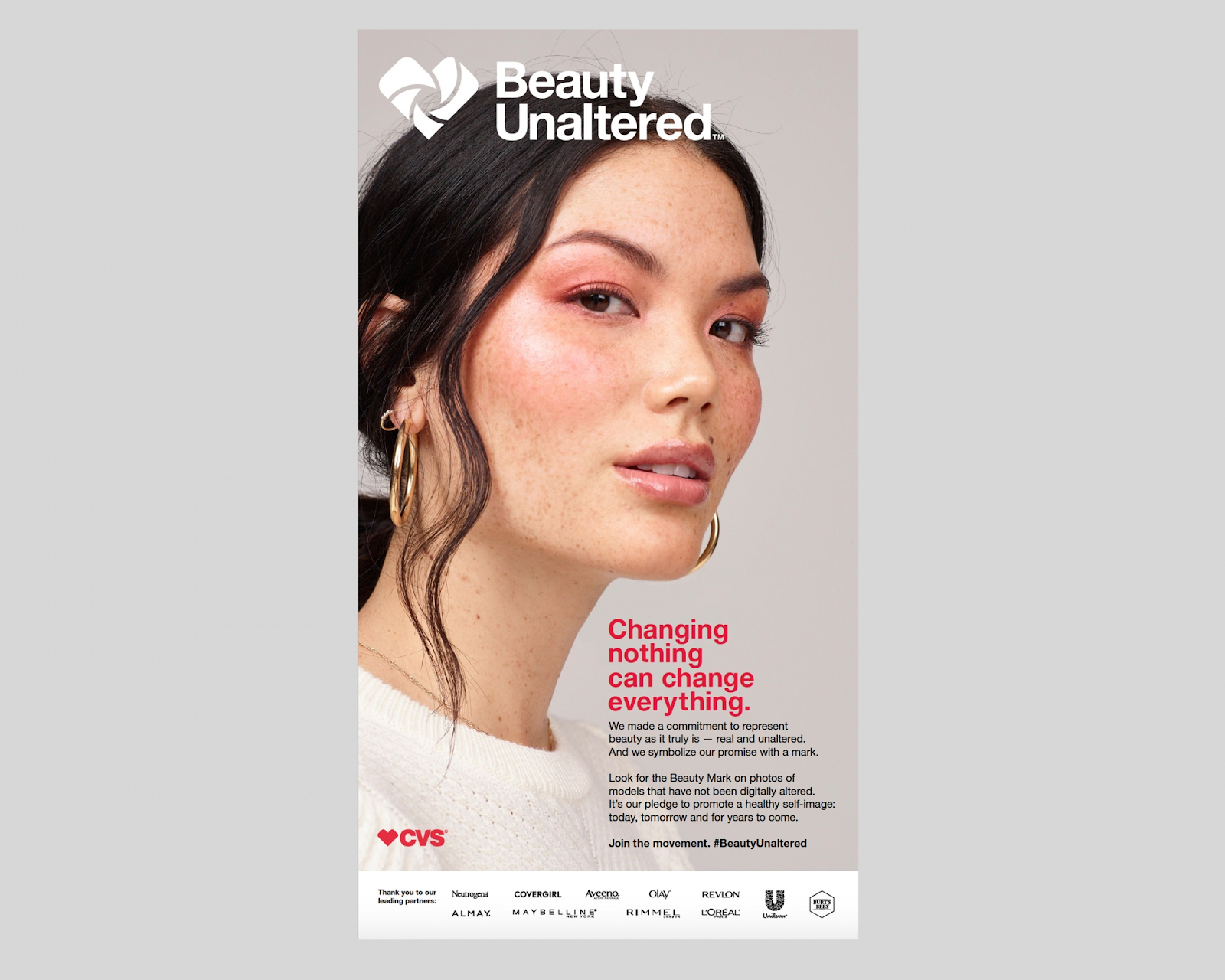
Photo from CVS Pharmacy
Photos on the pharmacy’s advertisements were either marked with a badge that said, "Beauty Unaltered" or "Digitally Altered." These badges made each ad more transparent about when an image was or was not retouched.
Along with changing the imagery in all of its stores, CVS promoted the campaign with physical signage, such as billboards. On social media, the pharmacy chain also launched a #BeautyUnaltered campaign which encouraged women to share unaltered photos of themselves.
CVS said the "Beauty Unaltered" campaign received mostly positive sentiment on social media. After the campaign was well-received, other major beauty brands like L'Oreal followed suit by presenting more digitally unaltered photos of women in their marketing materials.
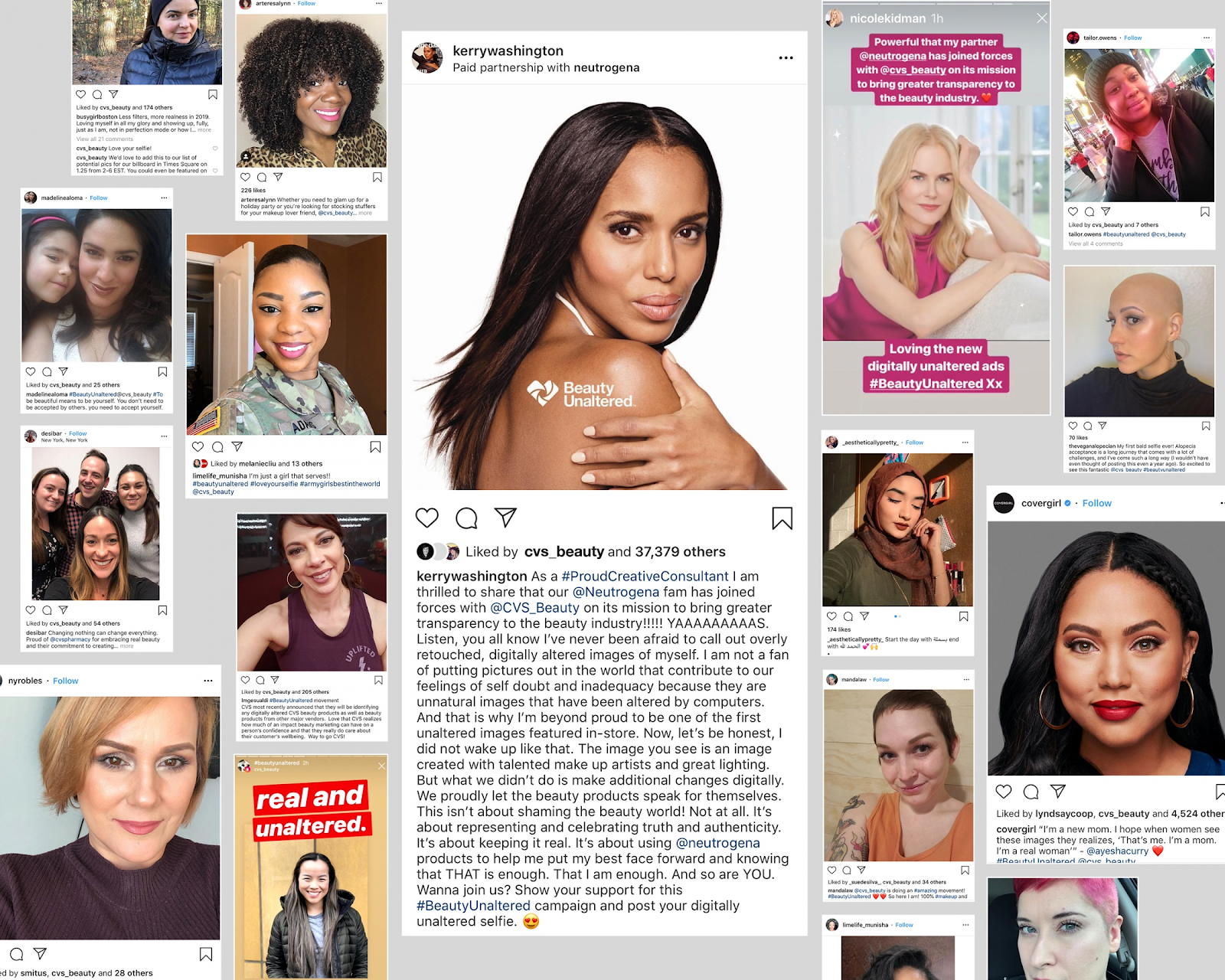
Photo from CVS Pharmacy
According to CVS's sizzle reel, the #BeautyUnaltered hashtag received over 104 billion impressions
While you might think that you need aesthetically pleasing airbrushed photos to sell your products, the CVS' campaign proves that showing real people can boost brand awareness and gain more trust and appreciation from your audience.
If you're marketing for a small company, take a note from CVS and highlight images of relatable looking people using your product. Even if you aren't selling beauty products, showing imagery or video of unedited, real-looking people will make the ad more relatable to other people.
For example, if you're advertising a gym, promoting images of heavily-airbrushed athletes might scare less athletic people away from signing up. Instead, consider showing prospects a mix of imagery with people from all age groups or fitness levels. That way, you can demonstrate to prospective customers that your gym is for everyone.
10. "ThisBelgianCase is for you" (Budweiser)
In this physical marketing campaign, Budweiser aimed to make bars and gas stations "Weiser." Get the joke?
During the campaign, Budweiser sponsored phone-charging stations in bars and electric car charging stations. Near or on each station, Budweiser included physical signage that said statements like, "This phone is being powered by Budweiser," or "This charging station is powered by Budweiser."
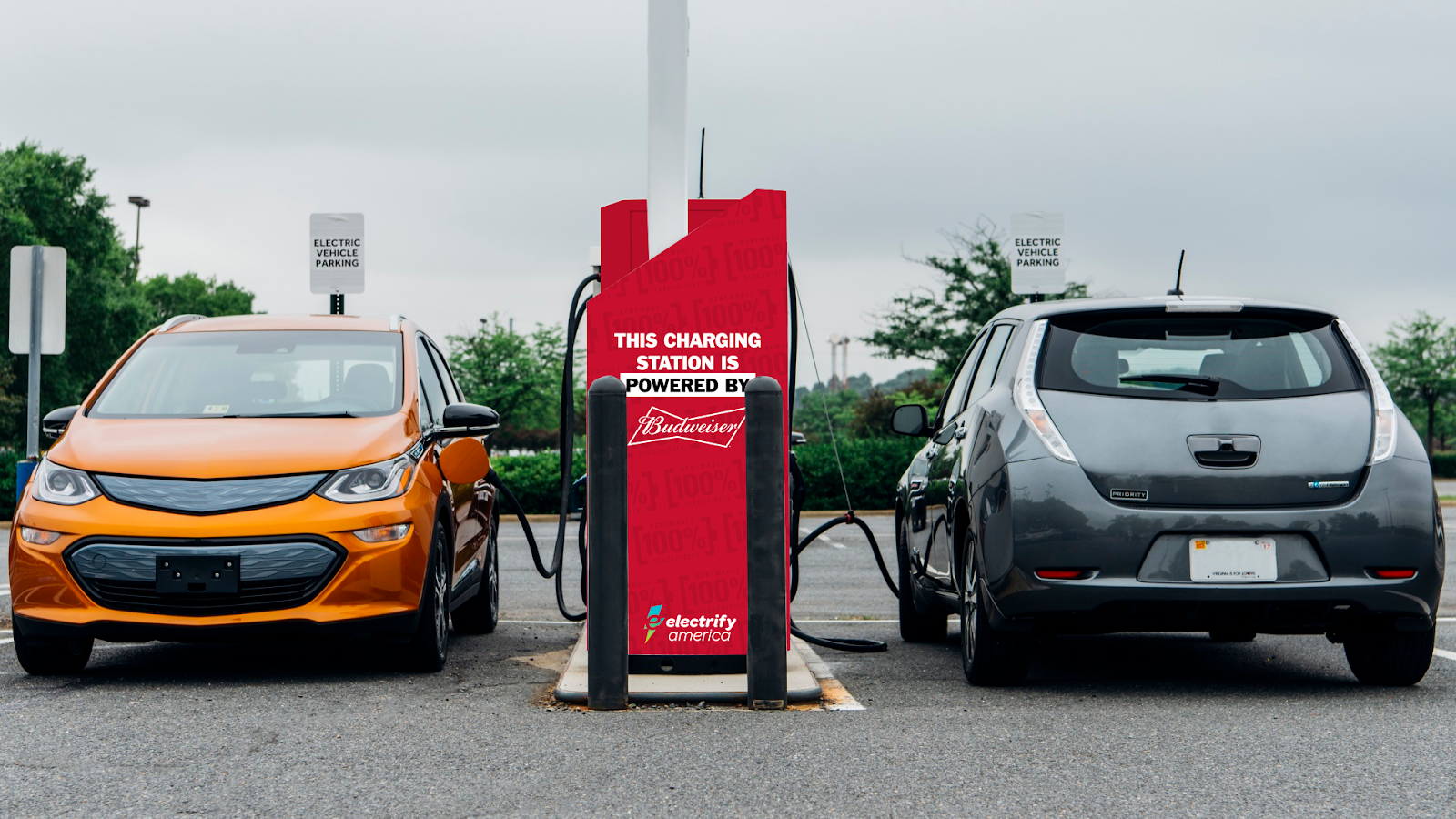
As part of the campaign, some of the signage said: "VOTE FOR YOUR BAR TO BECOME WEISER."
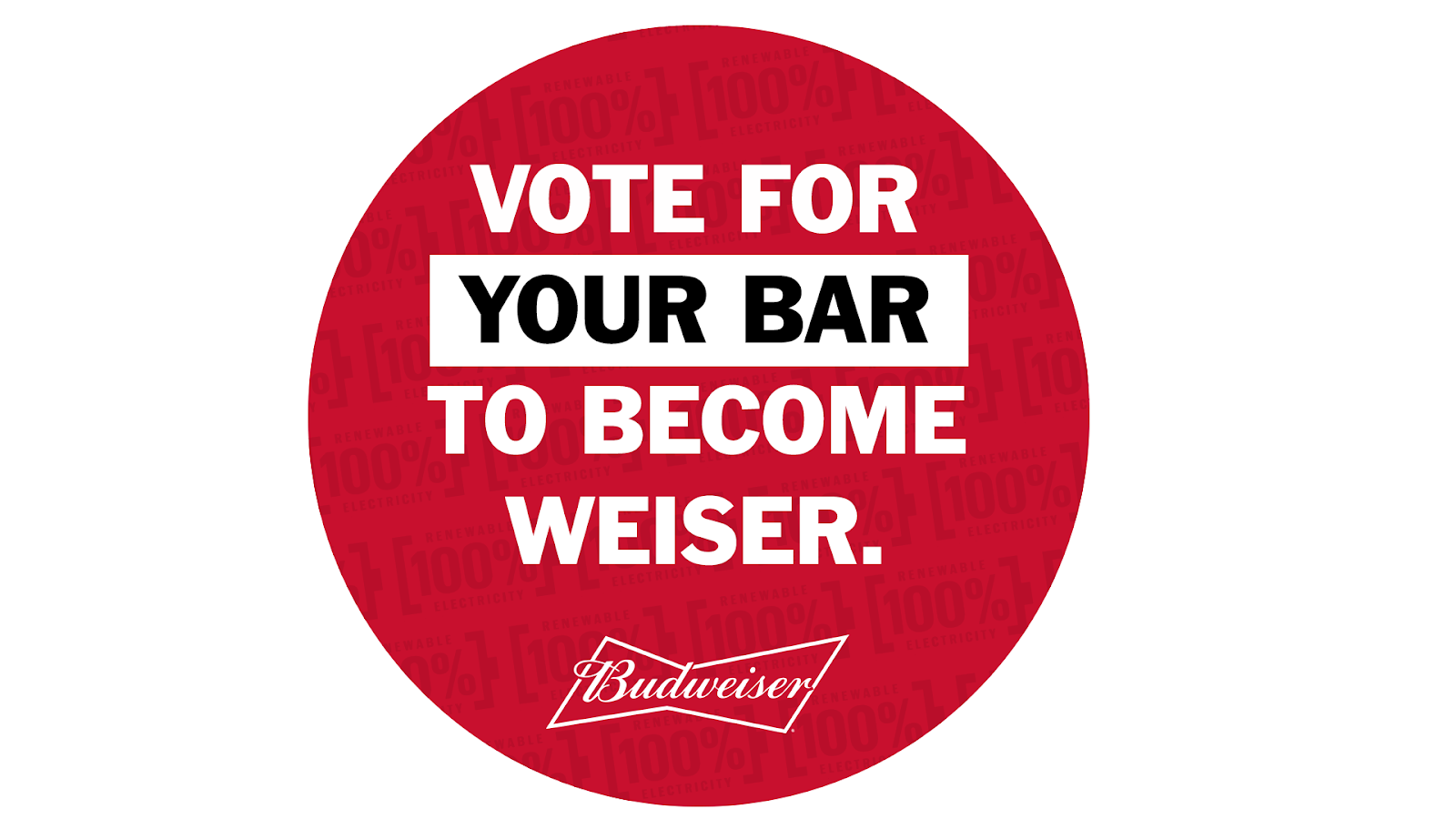
After seeing the "vote" call to action, audiences could go online and vote for bars that they wanted to have charging stations added to. Budweiser then used those votes to pick bars that would get sponsored charging stations.
The beer company markets to a general audience at or above the legal drinking age. In this example, they placed advertising on electric car stations and bar charging areas that audiences who are over the legal drinking age might see. This signage placement is another great example of creating a campaign that meets your prospective customers or audience where they commonly are.
While phone or car charging station sponsorships have nothing to do with alcohol, placing Budweiser ads strategically in front of audiences gives the company a way to spread brand awareness.
As a marketer for a smaller business, you can also find scaleable ways to identify where your audiences are and create marketing strategies around those locations.
For example, if you want to advertise a makeup line or boutique, you could consider buying sign space on the wall of a building that has a salon in it. In this scenario, people going to a salon to improve their looks might see the ad for your beauty products and want to purchase them.
Getting Campaign Inspiration
The marketers who created campaigns on this list offered a variety of content that grabbed attention from viewers and felt less like the average every-day ad. If any of these examples have inspired you, here's are a few scalable marketing tactics you can try next.
- Make a few marketing videos: Consumers prefer to learn about products through video. This might be why many Clio Gold Award winners decided to launch video-based campaigns. The good news is that you don't need to have a big brand budget to make an effective video. If you have time to make a video, start brainstorming ideas and check out this step-by-step guide for more scalable advice.
- Embrace word of mouth marketing There are a number of ways to get your customers and fans talking about your product in-person or online. Here's a great guide that walks you through where to start and how to run an effective campaign.
- Meet your prospects where they are: Budweiser sponsored charging stations in bars where people might order its beer. Meanwhile, Adidas offered Billie Jean King shoe designs at the U.S. Open tennis matches. If you've been inspired to do a physical campaign, these are prime examples of how companies can benefit from identifying where their major audience demographics are and creating strategies around those locations and trends.
Looking for even more award-winning marketing inspiration? Check out our rundown of Emmy nominated commercials.
Marketing Campaigns

.jpg)


![How to run a marketing campaign on a tight budget [expert tips & free tools]](https://53.fs1.hubspotusercontent-na1.net/hubfs/53/19_What%20is%20a%20Marketing%20Plan%20%26%20How%20to%20Write%20One%20%5B+Examples%5D.png)
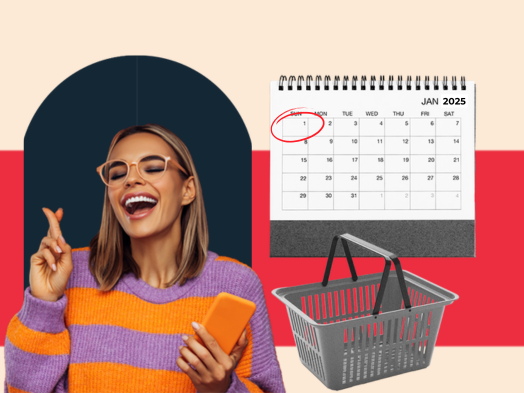
![How to Create a Successful Marketing Campaign [Strategies, Data, + Examples]](https://53.fs1.hubspotusercontent-na1.net/hubfs/53/marketing-campaign.webp)
![I Took a Deep Dive Into PERT to Create More Accurate Time Estimates [+ Templates, Examples, and Formula]](https://53.fs1.hubspotusercontent-na1.net/hubfs/53/pert-1-20250213-8082845.webp)
![4 Clever Olympics Marketing Campaigns [+Top Takeaways]](https://53.fs1.hubspotusercontent-na1.net/hubfs/53/best-olympic-marketing-campaigns-1-20240809-9542066.webp)
